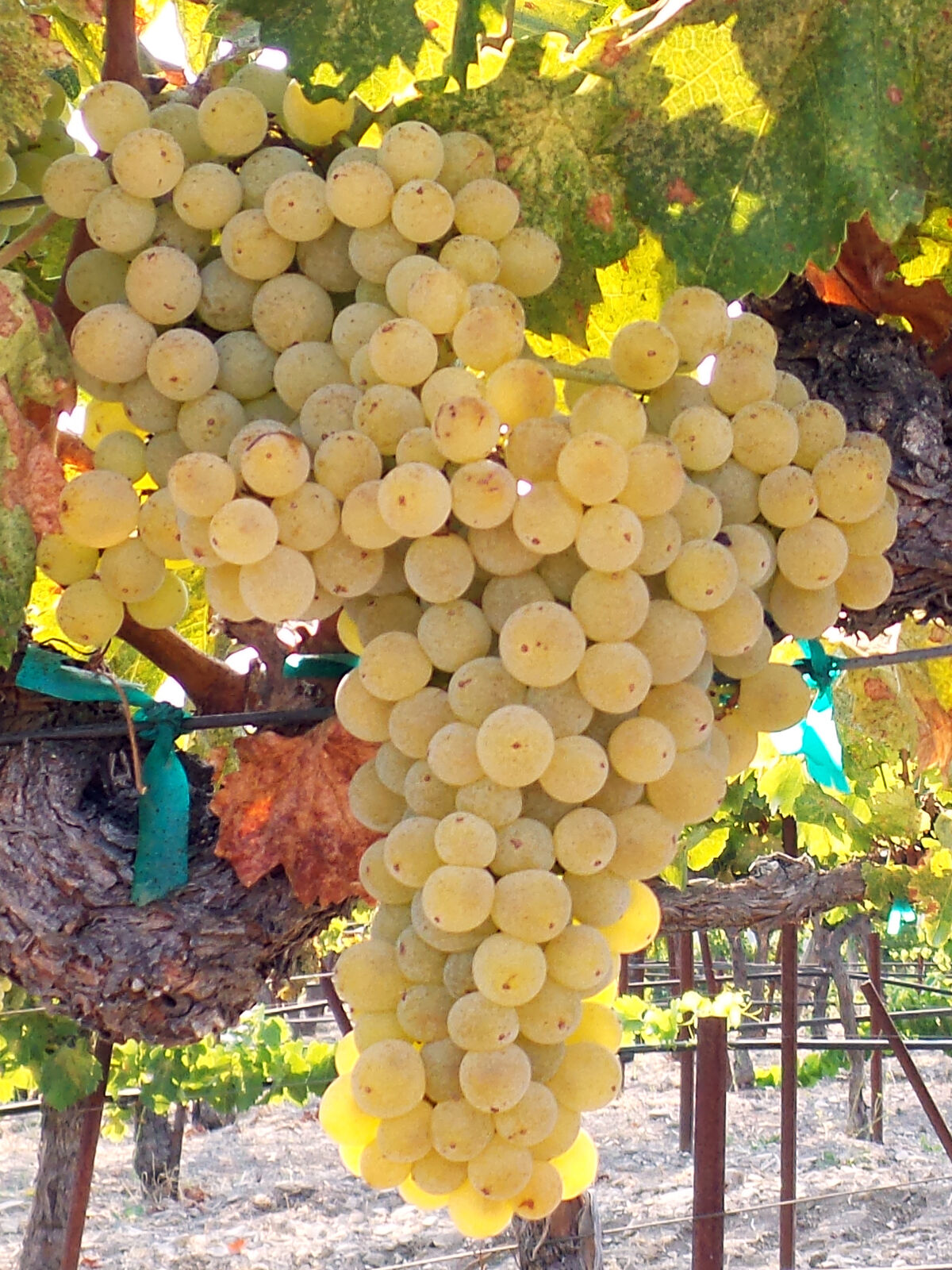Grenache Blanc
Grenache Blanc is the one of the most widely planted white grapes in the southern Rhone. It produces rich, full wines with bright flavors and crisp acidity and is a key element in our flagship white wine, the Esprit de Tablas Blanc, as well as the lead grape in our Patelin de Tablas Blanc. It is also growing in popularity as a single-varietal wine, particularly in California’s Central Coast.

The Basics
As the name suggests, Grenache Blanc is related to the more widely known Grenache Noir. Many grapes have both red and white variants; the best known is Pinot, which has Pinot Noir, Pinot Blanc and Pinot Gris variations. Grenache Blanc, like Grenache Noir, is drought-resistant, vigorous, easy to graft and ripens fairly early in the cycle, after Viognier and Marsanne, but before Roussanne. The California climate of hot days and cool nights seems to be perfect for the varietal and encourages its two prime qualities: rich texture and crisp acids.
History
Grenache Blanc originated in Spain, and still plays a role in the wines of Rioja and Navarre. From Spain, it spread to France, and has thrived in the vineyards of the Rhône valley and Châteauneuf-du-Pape. In Châteauneuf-du-Pape, the crisp acidity of Grenache Blanc is used to balance the honeyed richness of Roussanne, and white Château de Beaucastel is roughly 15% Grenache Blanc.
As of 2016, France held more than two-thirds of the world's acreage of Grenache Blanc, at 12,676 acres. Spain was second, at 5,093 acres, with the United States (636 acres) and South Africa (272 acres) the only other countries with significant plantings.
Grenache Blanc at Tablas Creek
We imported cuttings of Grenache Blanc from Beaucastel in 1992, and the vines spent three years in quarantine at the USDA station in Geneva, New York. In 1995, the cuttings were declared virus free and released to Tablas Creek Vineyard. These vines were received into our nursery and the first grafted vines went into the ground in 1996. Our first significant harvest of the varietal was 1999. For the next three years (up to and including the 2001 Esprit de Beaucastel Blanc), we could only refer to the varietal as Grenache on our label because Grenache Blanc was not yet recognized by the Bureau of Alcohol, Tobacco and Firearms. Not surprisingly, many people found this confusing and we were regularly asked why we added a red varietal into our white blend. In 2002 we petitioned the BATF to recognize Grenache Blanc as a separate varietal.
Grenache Blanc in California
Plantings of Grenache Blanc have grown steadily in the last 25 years, and seem poised to take off more in the near future. The 636 acres planted in California as of 2019 include nearly 300 planted since 2015. That acreage is now more than Roussanne and Marsanne combined, and second only to Viognier state-wide among Rhone whites. Roughly one quarter of all Grenache Blanc in California is planted in San Luis Obispo county, and most of the single varietal Grenache Blancs released in California have come from the Central Coast.
The roughly six acres we have planted at Tablas Creek represents about 17% of our white Rhone acreage.
Grenache Blanc in the Vineyard and Cellar
Grenache Blanc, like Grenache Noir, is drought-resistant, vigorous, productive, easy to graft and ripens fairly early in the cycle, after Viognier and Marsanne, but before Roussanne.
Grenache in all its colors is a vigorous variety with upright shoots that lends itself to “gobelet” or “head training”; it required by appellation law to be cultivated in this manner in Châteauneuf-du-Pape. It is equally happy on a trellis, and most of our Grenache Blanc is cultivated in double cordon fashion with six fruiting canes, each with two buds. We have learned that we're happiest with the grape when it produces between four and five tons of fruit per acre of vines.
In the cellar, we typically ferment Grenache Blanc in a balance of closed stainless steel fermenters, 1200-gallon foudres, and 600-gallon mini-foudres, to protect the grape from oxidation and give a range of brighter and richer expressions.
Aromas and Flavors
Grenache Blanc is straw-colored and produces wines that are full bodied, with crisp acids. The nose has bright green apple and mandarin orange aromas, with clean flavors of more apple, mineral and a touch of peach. It typically has a lingering finish with a hint of licorice.
We use Grenache Blanc in three ways. As a varietal bottling (we have bottled a varietal Grenache Blanc most years since 2002), the grape's combination of richness, brightness, and sweet spice make it a great companion with flavorful foods. As the lead component in a blend, as in our Patelin de Tablas Blanc, we play that citrus and spice off against richer grapes like Viognier and Roussanne, creating tension and interest. And as a supporting player in a blend, its brightness and minerality help highlight the lusher lead grapes like Roussanne in our Esprit de Tablas Blanc or Viognier in our Cotes de Tablas Blanc.
One additional bonus: the crispness of Grenache Blanc shows well at low temperatures, whereas many white Rhône varieties show little when served cold. In our Esprit Blanc, the Grenache Blanc allows the wine to show well, even highly chilled (as many restaurants often serve all white wines). As the wine warms up in the glass, the other varietals unfold, and the full richness of the wine is displayed.
This article originally appeared in one of our newsletters. Each newsletter, we spotlight the history and characteristics of one of our Rhone varietals. You can sign up for our mailing list.
You can view a one-minute video summary of Grenache Blanc on our YouTube page.
You can go back to the summaries of the different Rhône grape varietals.
